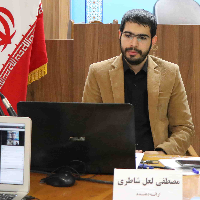The Influence of Judicial, Political and Military Norms of the First Half of the Qajar Period on the Illustration of Mirza Ali-Qoli Xu’i from the Retribution Council of the Ashqiya of Karbala by Mukhtar al-Thaqafi in Tufan al-Boka'
In the production of any work of art, illustrators are undoubtedly influenced by a set of pre-texts and paratexts, which often appear in the text (image) for a variety of reasons with a variable effect factor, as such trend is examined in the Qajar period (simultaneously with the arrival of the lithography industry). During this time, many books were illustrated, during which Tufan al-Boka' was reprinted several times due to the growing popularity of the audience. Relying on the descriptive-analytical method, the main question raised is the extent to which Mirza Ali-Qoli Xu’i (Activity period 1847-1855), as one of the first artists known in the field of illustration of lithographic books, was influenced by the norms of the society in the creation of the Karbala Ashqis Qisas Majlis by Mukhtar in Tufan al-Boka'. The findings from the study of individual versions of Tufan al-Boka' by Xu’i (7 lithographic versions: 1849, 1852, 1854, 1856a, 1856b, Dateless a, Dateless b) indicate that regarding the existing pretexts of this event as a written discourse (base: Early Century Sources, contemporary: Tufan al-Boka'), they considered the nature of three norms (judicial: corporal punishment, military: military cover and tools, political: court iconography), and were distributed and welcomed using the image, as a dynamic media, seeking to connect the audience more with this event with a special attitude and analyzable based on the theory of reflection and shaping - first by showing everyday topics and then, while visually replacing Fath Ali Shah with Mukhtar, he intended to gain relative acceptance for the ruling power. In the production of any work of art, illustrators are undoubtedly influenced by a set of pre-texts and paratexts, which often appear in the text (image) for a variety of reasons with a variable effect factor, as such trend is examined in the Qajar period (simultaneously with the arrival of the lithography industry). During this time, many books were illustrated, during which Tufan al-Boka' was reprinted several times due to the growing popularity of the audience. Relying on the descriptive-analytical method, the main question raised is the extent to which Mirza Ali-Qoli Xu’i (Activity period 1847-1855), as one of the first artists known in the field of illustration of lithographic books, was influenced by the norms of the society in the creation of the Karbala Ashqis Qisas Majlis by Mukhtar in Tufan al-Boka'. The findings from the study of individual versions of Tufan al-Boka' by Xu’i (7 lithographic versions: 1849, 1852, 1854, 1856a, 1856b, Dateless a, Dateless b) indicate that regarding the existing pretexts of this event as a written discourse (base: Early Century Sources, contemporary: Tufan al-Boka'), they considered the nature of three norms (judicial: corporal punishment, military: military cover and tools, political: court iconography), and were distributed and welcomed using the image, as a dynamic media, seeking to connect the audience more with this event with a special attitude and analyzable based on the theory of reflection and shaping - ...
-
Analyzing the Problems of agricultural cooperatives in Iran: qualitative meta-synthesis of scientific articles
Hosein Feizabadi *, Aliakbar Majdi, Golamreza Hasanidarmyan,
Journal of Community Development, -
Perspective in Seyyed al-Shaara's lithographic works (case study: illustrations of Bahr al-Fawaed book)
Zohreh Sarabi, Mostafa La’L Shateri *
Ferdows Honar, -
American Trading Houses’ Activities in Mashhad in the Late Qajar Period
JALIL Ghassabigazkouh *,
Journal of Documentary and Archival Studies Research,




